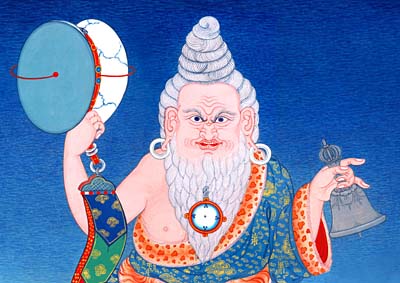
Bell and gÇod Damaru
characteristic implements of the gö-kar chang-lo’i dé
This detail from the thangka of Rang-rig Togden shows a yogi playing the characteristic implements of the gö-kar chang-lo’i dé. Anyone who has visited any of the Nyingma centres on the West Coast of America, or who has attended an Open Teaching Retreat with one of the Aro gTér Lamas, will be aware that the bell and gÇod drum are central to practice. This is particularly the case in the Confederate Sanghas of Aro – where the bell and gÇod drum are used extensively to accompany yogic song. For many people in the West, the gÇod drum is thought of as being solely for the purposes of gÇod – but it has many other functions with regard to practice. The gÇod drum is used within the sadhana (drüp-thab – grub thabs) of Tröma Nakmo for the protector practices, and there are even divination methods which employ the gÇod drum.
The most common type of gÇod drum measures roughly 9 to 10 inches or often less – but the Aro gTér, amongst other traditions, employs a much larger drum, roughly 11 to 14 inches in diameter. The size of a gÇod drum is usually said to be defined by the size which would fit under one’s arm when the extended fingers touched the waist (for a man) and when the extended fingers touched the armpit (for a woman). Within the Aro gTér tradition, however, no distinction is made between the size of drum for men and women.
